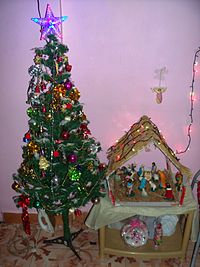Musim Krismas

Musim Krismas (juga dikenali sebagai Musim Natal atau Christmastide dalam Inggeris ) ialah suatu musim tahun liturgi di kebanyakan gereja Kristian. Dalam sesetengah denominasi Kristian, Musim Krismas adalah sama dengan Twelvetide, konsep yang sama.
Bagi kebanyakan denominasi Kristian, seperti Gereja Roman Katolik, Gereja Lutheran, Gereja Anglikan dan Gereja Methodist, Krismas bermula pada 24 Disember sewaktu matahari terbenam atau Vespers, yang secara liturgi adalah permulaan pada Malam Krismas . [1] [2] [3] [4] Oleh itu, sebahagian besar 24 Disember bukanlah sebahagian daripada Krismas, tetapi Adven, musim dalam Tahun Gereja yang mendahului Krismas. Dalam banyak kalendar liturgi, Musim Krismas diikuti pada waktu matahari terbenam pada 5 Januari, dikenali sebagai Malam Kedua Belas, oleh musim Epiphanytide yang berkait rapat. [5] [6]
Terdapat beberapa perayaan dalam Krismas, termasuk Hari Krismas (25 Disember), Hari St. Stephen (26 Disember), Childermas (28 Disember), Malam Tahun Baru (31 Disember), Perayaan Berkhatan Kristus atau Hari Raya Maria, Ibu Tuhan ( 1 Januari ), dan Perayaan Keluarga Kudus (tarikh berbeza-beza). Dua Belas Hari Krismas berakhir dengan Malam Epifani atau Malam Kedua Belas (petang 5 Januari). [7]
- ^ Satter, James (24 March 2005). Lutheran Handbook (dalam bahasa English). Augsburg Books. ISBN 978-1-4514-0321-3.
The liturgical color for Christmas is white, which reminds us that Jesus is the Light of the world. Christmas lasts for 12 days, from December 25 to January 5. Epiphany is celebrated on January 6, when we remember the three Wise Men's visit to the Christ child.
CS1 maint: unrecognized language (link) - ^ Hickman, Hoyt Leon (1 April 1984). United Methodist Altars. Abingdon Press. ISBN 978-0-68742985-1. Dicapai pada 5 January 2015.
Christmas eve: Begins at sunset December 24 and is part of Christmas, since the days of the Christian year traditionally begin at sunset the previous day.
- ^ "Introduction to Christmas Season". General Board of Discipleship (GBOD). The United Methodist Church. 2013. Dicapai pada 5 January 2015.
Christmas is a season of praise and thanksgiving for the incarnation of God in Jesus Christ, which begins with Christmas Eve (December 24 after sundown) or Day and continues through the Day of Epiphany. The name Christmas comes from the season's first service, the Christ Mass. Epiphany comes from the Greek word epiphania, which means "manifestation." New Year's Eve or Day is often celebrated in the United Methodist tradition with a Covenant Renewal Service. In addition to acts and services of worship for the Christmas Season on the following pages, see The Great Thanksgivings and the scripture readings for the Christmas Season in the lectionary.... Signs of the season include a Chrismon tree, a nativity scene (include the magi on the Day of Epiphany), a Christmas star, angels, poinsettias, and roses.
- ^ Hickman, Hoyt Leon (1 April 1984). United Methodist Altars. Abingdon Press. ISBN 978-0-68742985-1. Dicapai pada 5 January 2015.
Christmas Season: From sunset December 24 through January 6. The season celebrating the birth and manifestation (epiphany) of Christ.
- ^ Mangan, Louise; Wyse, Nancy; Farr, Lori (2001). Rediscovering the Seasons of the Christian Year. Wood Lake Publishing Inc. m/s. 69. ISBN 9781551454986.
Epiphany is often heralded by "Twelfth Night" celebrations (12 days after Christmas), on the evening before the Feast of Epiphany. Some Christian communities prepare Twelfth Night festivities with drama, singing, rituals - and food! ... Sometimes several congregations walk in lines from church to church, carrying candles to symbolize the light of Christ shining and spreading. Other faith communities move from house to house, blessing each home as they search for the Christ child.
- ^ Pennick, Nigel (21 May 2015). Pagan Magic of the Northern Tradition: Customs, Rites, and Ceremonies. Inner Traditions – Bear & Company. m/s. 176. ISBN 9781620553909.
On Twelfth Night in German speaking countries, the Sternsinger ("star singers") go around to houses carrying a paper or wooden star on a pole. They sing an Epiphany carol, then one of them writes in chalk over the door a formula consisting of the initials of the Three Wise Men in the Nativity story, Caspar, Melchior, and Balthasar, with crosses between them and the year date on either side; for example: 20 +M+B 15. This is said to protect the house and its inhabitants until the next Epiphany.
- ^ Wickham, Glynne (5 September 2013). Plays and their Makers up to 1576 (dalam bahasa Inggeris). Routledge. m/s. 42. ISBN 9781136288975.
Again, however, the feasts appointed to follow Christmas [Day] like those following Easter are all celebrations: St Stephen (26 December), St John the Evangelist (27 December), Holy Innocents (28 December), Circumcision (1 January) and Epiphany (6 January). Collectively they make up the Twelve Days of Christmas, terminating with Twelfth Night.
